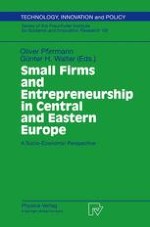2002 | OriginalPaper | Buchkapitel
Possible Strategies and Policy Steps for an Innovation Oriented Modernisation
verfasst von : Günter H. Walter
Erschienen in: Small Firms and Entrepreneurship in Central and Eastern Europe
Verlag: Physica-Verlag HD
Enthalten in: Professional Book Archive
Aktivieren Sie unsere intelligente Suche, um passende Fachinhalte oder Patente zu finden.
Wählen Sie Textabschnitte aus um mit Künstlicher Intelligenz passenden Patente zu finden. powered by
Markieren Sie Textabschnitte, um KI-gestützt weitere passende Inhalte zu finden. powered by
Industrialisation and technology within large production complexes had been a key component of Central and Eastern Europe’s economic performance throughout the post World War II period. Nearly all countries within the area of influence of the former USSR had developed a science and technology (S&T) system similar to the Soviet pattern. This system had three elements: an Academy of Sciences for the leading researchers, and often highest priority for public funding, industrial or branch research institutions as a technology base for industry, and universities for education. Research institutions were not treated as autonomous entities but were controlled by respective ministries. As a result of the collapse of the socialist system, the links between industry and the S&T system disappeared (Bitzer 1998). With the beginning of the transition period, however, reforms and restructuring of both the S&T system and the industry sector led to considerable losses in the research potentials of all CEECs. The main negative tendencies were a declining gross expenditure on R&D and a decreasing number of R&D personnel, sometimes leading to a brain drain, i.e. either an external (for the country) or internal (for industry) loss of scientists and workers. While these often drastic changes are described perfectly elsewhere) the question arose of how to achieve industrial restructuring. Many concepts by policy makers and consultancies were offered to CEECs. However, all of them were rooted in the structures of the industrialised countries of the western hemisphere, and very often they were simply adopted by the CEEC authorities, taking the effectiveness of these technology and innovation policies for granted. Today, additional hurdles apart from the problem of financial means are created by the fact that existing and planned technology and innovation policies in the CEECs are not regarded in their entirety and are only evaluated for their specific effects in initiating and realising innovation activities in the different groups of enterprises. Moreover, many concepts are still in their infancies.
